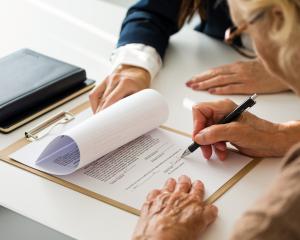Ross Johnston says the small Blueskin Bay wind-farm project is the most exciting, innovative and visionary venture he has been involved with.
When Noah was threatened by a flood, he built an ark.
When members of the Waitati community were threatened by a flood in 2006, a few far-sighted members of the community created a trust, the Blueskin Resilient Communities Trust, or BRCT.
There was a lot of discussion and argument about what should be done and how it should be done.
Over the years, members changed, but the trust survived.
The trust's vision hasn't changed: resilient communities around Blueskin Bay that could be involved in looking after themselves.
To do that, they need money, because, as anyone who has been on a community committee knows, you might have the energy and the time, but the lack of money holds you up and stymies good ideas.
So if you want to earthquake-proof your community hall, or replace toilets on a recreation area, or get a scheme going that allows locals to insulate their homes cheaply, or maybe import affordable solar panels to help locals minimise their electricity bill ... you need money.
Money to use, money to access more money.
So that is what the proposed Blueskin wind farm is all about.
Providing money for our communities ... and we've travelled an intriguing road to get this far.
The trust's focus has largely been on energy.
Lots of schemes were developed, considered and discarded: generating electricity from the tide, a small hydro scheme, solar, steam, DIY household wind turbines.
One idea that really appealed was the thought of free or cheap power.
Could we build one big wind turbine to supply all these communities with cheaper electricity, because we're all on the same substation?
Well, no, we couldn't raise that sort of money locally; we're not rich communities.
Besides, there were other problems.
Wind comes and goes, it's not a continuous source of power, so we'd have to supplement the electricity supply.
We'd have to become a power company, and that, we found, is insanely complex and difficult.
And we'd be selling into a Blueskin market where many people were minimising their consumption of electricity or wanted to go off the grid.
We'd have to do the billing, sort the line charges, employ staff ... not a starter.
But out of that idea, another was born.
If the trust could get a resource consent for a small wind farm with three or four turbines, then it would have sweat equity in that project.
In other words, a resource consent for a wind farm has a monetary value - that's our sweat equity.
It's a significant and valuable contribution to a project.
Problem.
There is an enormous amount of work in checking out the feasibility of such a project and applying for a resource consent.
Sites need to be found, small towers erected to test the wind on the best sites over time, landscape architects need to be consulted, different types of turbines assessed to ensure their suitability for our conditions, leases have to be to negotiated, financial projections carefully developed and evaluated - the list was endless.
But over five long years, the trust successfully worked through those requirements.
But another problem.
There would need to be a company, with investors, to make it all happen.
Wouldn't that mean the other investors could overpower us and do what they liked?
Well, yes, if it were a normal company. But a charitable company, where the control remains with the charity, sounded like a better idea.
So BRCT set up a charitable company, Blueskin Energy Ltd (BEL).
Problem.
BEL has to have a business case for the wind farm that is attractive enough to investors so they are happy with the return and also happy enough to invest without having the normal investors' rights.
Fortunately, there are already other companies that successfully work this way, particularly if they are engaged in green projects.
We would need a good business case, so we developed one.
To our delight, we've found a number of investors who have expressed interest in our plan.
Problem.
To secure that sort of investment, we need a contract with a buyer (or buyers) for the electricity we generate.
It needs to be a long-term contract (say 20 years) to ensure that those investors are secure.
It seems such a contract is possible.
If all this falls into place, then we can set up something like the Otago Community Trust to distribute the returns we get from our sweat equity - the resource consent - to our communities.
It's been an amazing journey, and at last the resource consent application has been lodged, so it's feet-up time for the first time in years.
Will all this happen?
I can't tell you.
What I can tell you is that this is the most exciting, innovative and visionary venture I've ever been involved in.
● Ross Johnston, of Purakaunui, is a member of the Blueskin Resilient Communities Trust.










